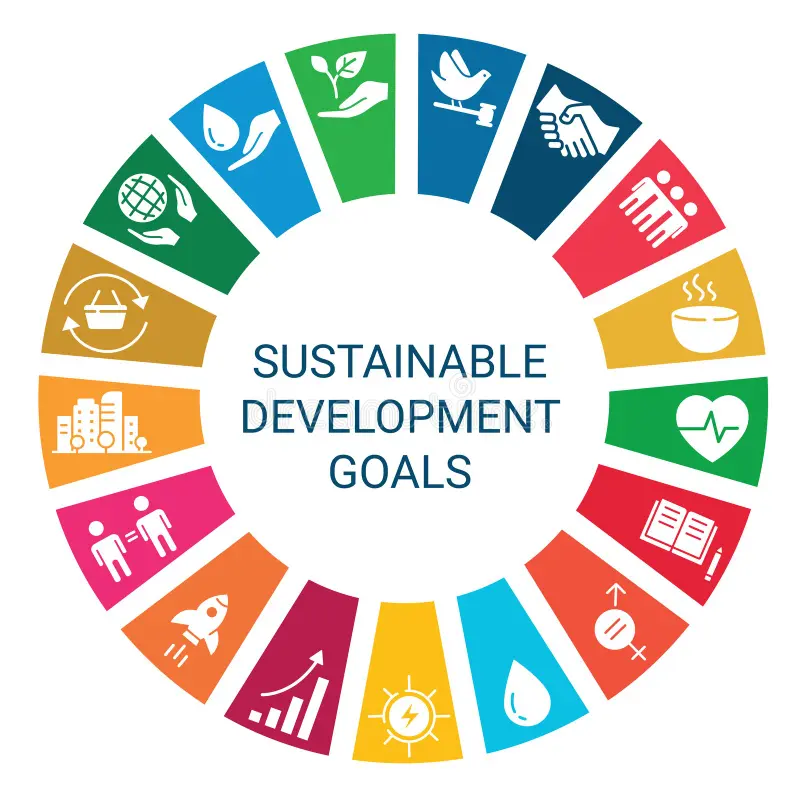Goals “In Peril”
The UN’s Sustainable Development Goals probably won’t be achieved. Apologies for the glum start but we are simply reflecting on July’s update from the organisation itself.
In a press release, the UN said the goals are “in peril”, adding “for the first time in decades, development progress is reversing”.
The 17 goals were set in 2015 with a deadline of 2030, mid-2023 marking the halfway point. Many of them won’t be relevant to you directly, but some will, and may be central to your corporate social responsibility (CSR) pledges.
There were great intentions in 2015, which many countries bought into, as did individual businesses. However, now we find that only 12% are on track. And so, here we are. It is not for us to suggest why progress has been so slow, although perhaps the size of the task has put many off.
The UN has called for a “half-time team talk” saying “we must do what all the greatest teams do when they are down at half-time: band together and take action”.
Success will take a renewed commitment from all concerned, and as ever they require everyone to do their part, however small that may be.
You can potentially do your bit by addressing four of the 17 goals with some help from us, utilising our expertise in making the transition from education to the workplace more egalitarian, with equal opportunities for all.
How You Can Address Four UN Sustainability Goals
Much of the focus towards achieving the goals has been centred on children and the generations that will be leading change post 2030. The Sustainability Hour is an initiative designed to get people to volunteer in schools and engage with young people, helping them to learn more about sustainability.
Ensuring students gain relevant work experience and experience a wide range of opportunities can also be of great importance. Work experience can boost confidence and develop important workplace skills. The impact is shown in the fact that those who have at least four brief placements are 80% less likely to find themselves NEET - not in education, employment or training.
The opportunity to work in a wider range of industries should therefore not be a privilege. It should be equally available to all.
And giving more students a wider appreciation of the options open to them can boost your company’s social impact, and work towards achieving these four specific UN Sustainability Goals.
In the rest of this post, we look at the four individually with thoughts on how we can all do our bit.
“Ensure inclusive and equitable quality education and promote lifelong learning opportunities for all”
The ‘lifelong opportunities’ elements of UN Sustainability Development Goal (SDG) 4 is relevant to many.
One example of a business embracing its responsibilities is communications company Avanti which has become a “Business Avenger” , using its network of partners to deliver educational programmes throughout Africa. Courses are delivered using tailored eLearning platforms accessible through satellite internet connectivity.
Removing the geographical obstacles to opportunity in this way is a huge step forward to achieving this goal. Through our own work we have seen how work experience is so often closed to those without the connections to help them succeed.
But, in another positive example worthy of note,Network Railcreated a virtual work experience programme that raised awareness of their own organisation but also boosted student confidence and helped those undertaking the programme enhance their employability skills. 258 students took part and the programme increased their confidence in future prospects by more than 20%, plus increasing industry awareness by 100%.
An active and diverse talent development strategy means that, though a young person may not come to work for your organisation, they will at least have been able to consider it as an option. They will have had an opportunity.
“Achieve gender equality and empower all women and girls”
Tackling gender inequality will remain ongoing but by ensuring the next generation of women has access to more opportunities in the workplace we can make some significant steps to address UN SDG 5.
The GoogleImpact Challenge for Women and Girls commits $25 million to fund organisations creating pathways to prosperity, although there is plenty your organisation can do right now to redress the gender imbalance.
Google.org Impact Challenge for Women and Girls | When She Rises, We All Rise
A lack of representation can be hugely damaging as girls might have an interest in a particular area and yet assume that the office lacks role models in a heavily male-dominated profession. They will be disinclined to apply for work experience or apprenticeship programmes.Accenturepublishes its organisation’s gender equality statistics, proudly displaying that 50% of board members are women, but not shying away from measures to improve representation in other areas.
A key way to achieve greater equality is through recruitment, somethingSiemensrealised when they asked us to create a virtual work experience programme that would contribute towards gender and diversity balance within their company. 61% of the 843 participants were from a minority ethnic background, whilst 38% were female, compared to only 24% currently in technology roles.
By 2030, between five and six million children in the UK (based on Statista data of children aged five to 14 in the UK) will have moved into the age group best suited to secondary-school work experience.
Now is the time to start working to ensure equality of opportunity for them all.
“Promote sustained, inclusive and sustainable economic growth, full and productive employment and decent work for all”
There are huge barriers to providing full and productive employment for all.
In many countries opportunities simply do not exist, and there is a real need for companies to think creatively and help governments solve this problem. In Ghana, SAP created a programme connecting the informal economy of waste pickers to the formal economy, ensuring workers receive a fair wage and, eventually, have access to services including training and childcare.
The programme also addressed the huge problem of plastic waste not being recycled and causing pollution, something that damages much of the developing world.
If projects such as this are slightly beyond your scope, there are plenty of communities closer to home that are often excluded from opportunity. Their location or the logistics of travel might make a job, or even physical work experience placement impractical. A placement might be financially impossible, or it might appear overwhelming, a student with additional needs such as autism might assume the office would lead to sensory overload and so choose not to apply.
This is one area where virtual work experience can provide a significant advantage, as it strips away the barriers to placement. Anyone with internet access, even in a library, internet cafe, school or on their phone can engage in a course. Any student, anywhere can experience any company in the world. That is a wonderful thing.
Pret a Manger created a virtual work experience programme that not only showed the job roles available within its own company, but provided modules to boost students’ employability skills. Pret wanted an ethnically diverse cohort weighted towards female students. We were able to deliver an engaged group where more than three-quarters were female and more than half non-white. This could make all the difference to thousands of young people and companies that open up opportunities to a wider range of young people can make a big step towards making UN SDG 8 a reality.
“Reduce inequality within and among countries”
This goal might seem like a big task and reducing inequality will require an attitude shift from everyone in a position to make a difference.
Ultimately all have to contribute for UN SDG 10 to be achieved and one case study for contribution comes from Diageo. Similar to the Google example earlier, Diageo created a $20m fund, in their case to help black communities and businesses recover from Covid-19.
On a smaller scale, Engineers Irelanddelivered a virtual work experience programme specifically aimed at a diverse cohort of students who might not be able to attend an in-person placement. It also sought to redress the balance of a traditionally male-dominated profession, 60% were minority ethnic and 38% female. The best way to start reducing inequality is by working with those currently in education, to give them more options on leaving school.
Achieving Your Targets
These may seem like worthy aims, but why should you or your company concern yourselves with goals set by the UN?
Firstly, there is the simple economic equation that raising awareness of your company among a wider range of young people radically increases the potential future talent pool.
Secondly, it is likely you will have set some CSR goals and have in place diversity and inclusion policies. However, turning policy into reality can, like the UN Goals themselves, be difficult to achieve.
While you may have good links with certain schools, those schools may not be representative of wider society, and if limited by geography this will cut down the number of young people aware of your offering.Countryside Partnerships, for instance, provided a meaningful and inclusive work experience opportunity in line with the company’s diversity and inclusiveness values, they were keen to engage the hard-to-reach groups of those with special educational needs, who comprised 4% of the cohort, with those having experience of the care system making up 3%.
By actively targeting those from a wide range of backgrounds, over a much larger geographical area, you can ensure that many more young people will actually take advantage of the opportunities you have to offer.
But how can you do this?
Create A Bespoke Programme
On our platform, employers can create a bespoke programme that starts to build a talent pool through virtual work experience and targeted campaigns. An excellent example is the programme we created forVodafone, their objectives were threefold; increase industry awareness and awareness of roles within the business, demonstrate their appeal as an employer and reach a highly diverse student cohort.
In time, this can lead to in-person work placements too, it can create a funnel of thousands of interested students, some of whom may ultimately become future employees.
Your programme is built with the help of our expert content team, examples of common elements are:
- Introductions to your business units
- Bespoke events and experiences
- Employability and career Skills
- Live and on-demand talks
- Q&A sessions
- Job and apprenticeship adverts
- Targeted campaigns to promote opportunities within your organisation to students
The programme allows students to engage with you as much or as little as they want. Importantly, they all have the opportunity, and a real opportunity.
Discuss Creating Your Programme Today
Join the likes of Siemens UK and Vodafone in creating your bespoke programme with Springpod and gain access to a truly mixed cohort of tens of thousands of students.





